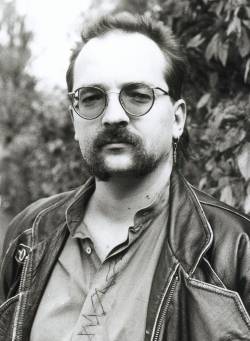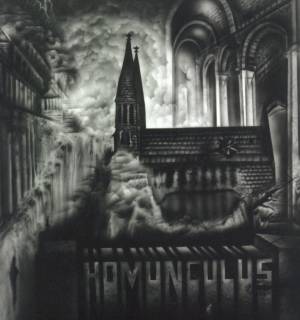One of the first things that attracts the attention most in his paintings, is the use he makes of black and white to enhance certain themes or elements. Thus for instance, his landscapes of narrow medieval streets look like pictures extracted from accursed books, and his ghostly Gothic cathedrals have an undeniably evil aura. Looking at some of those black and white elements, as for example the entire series of "Homunculus", it must be admitted that in full color they would not be so very impressive. He also incorporates this technique into photography and even to his own person, and decides he is one of these elements that must appear in black and white. Therefore, he always prefers photos to show him in black and white, instead of color.
 Some of his illustrations, as for instance the mass of human remains that presides the cover of his first album, or the poster that is included in his second album, show his vincle to death and Beyond. He sees these universal enigmas as a key for his creativity.
Some of his illustrations, as for instance the mass of human remains that presides the cover of his first album, or the poster that is included in his second album, show his vincle to death and Beyond. He sees these universal enigmas as a key for his creativity.
In a great part of his paintings there reigns a nocturnal atmosphere, perhaps enhanced by the timetable of his artistic work; Frohmader has produced his works mostly at night, at least in the past. And an oneiric texture, nightmarish in nature, pervades these paintings as well, so as to try harvest some of the essence of bad dreams, by means of atavistic, ancestral signs, from terror. The final effect is to reflect the things that each observer of the painting would swear to have dreamed in some nocturnal nightmare.
Nevertheless, his work is not as dark as many people believe, and this is an important point. Frohmader has become famous as an "accursed artist" because the most remarkable part of his art is the sinister content, and therefore, this is what is more popularized. In his music there also are passages of light and beauty, a sincere message as opposed to the commercial productions that have appropriated the term "New Age".
In his paintings, he shapes cosmic adventures where the observer can contemplate lakes and rocks made from light, the origin of life fused with the birth and death of suns, exuberant jungles spreading to the horizon, intergalactic starscapes swept by the cold light of nebulae, or simply the Sun rising from the clouds and shedding its light after a storm.
Up to a certain point, the dark and light aspects of Frohmader's art have a chronological distribution throughout his career. And thus we have that in the first years darkness, the macabre, the evil dominate; while in his latter years it is light, beauty, the cosmic, what takes the place of the former. Although in the mid 1980s, with "The Jules Verne Cycle" (two pieces based on two stories by Verne: "The Mysterious Island" and "20,000 Leagues Under the Sea"), this subtle change can already be appreciated, it isn't until 1988 with "Spheres", when Frohmader leaves the dark regions and makes a cosmic voyage towards the worlds of light. This new artistic and aesthetic concept continues in the CD "Miniatures" (1989), whose cover is a painting on the wave of the German futuristic trends of the 1920s - 1930s; as well as in 1990, in the CD "Macrocosm" (released in the United States). The final jump arrives with "3rd Millenium's Choice Vol.1", which closes the circle, and which in a way means a return to the original starting point, even though from a different angle. By the end of 1990, he engages on a trip to the French Brittany, so as to find artistic inspiration and produce a 20 minute film showing landscapes and impressions in his personal style, including music. This music is included in his CD "Armorika", running time 74 minutes, released at the beginning of 1991. The result is a very dense, imaginative work, specially in the themes "Tumulus", "Les Roches du Diable", and "Dolmen". At the beginning of 1992, his CD "3rd Millennium's Choice Vol.2" is released, a meditative excursion that enters science-fiction rather than terror. Later, new, excellent works appear.
 COLLABORATIONS, CONTACTS AND INFLUENCES
COLLABORATIONS, CONTACTS AND INFLUENCES
He is a good friend of Florian Fricke, the alma mater of the mystic music band Popol Vuh, known for their cosmic music since the early 1970s, as well as their movie soundtracks for German movie -maker Werner Herzog at an international level.
Musically speaking, he has collaborated with Ax Genrich from Guru-Guru, and Christoph Karrer from Amon Düül-2, members from two legendary bands of German psychedelic music, predecessors to the New Age movement. In his recordings sometimes collaborate violinists Stephan Manus and Iva Bittová, Stephan Seithel (Oboe), Birgit Metzger (vocals), and others. Through Nekropolis Records, his record label, he has produced CDs from other interesting alternative musicians, as for instance Andreas Merz and Gerd Schedel (two electronic experimental composers from Munich), and Gulaab.
He has worked with the painters of contemporary fantasy art Ernst Fuchs and Hellmut Neukircht; and he has been in contact with sculptor Martin Schöneich as well as painters Wolfgang Ohlhäuser and Elke Wassmann.
Among his influences we find the Gothic horror movies from silent movies, as for instance the "Nosferatu" by Murnau, besides the metaphysical science-fiction movies from Russia and Poland, among them "Solaris" and "Stalker". As for the writers who have influenced him most, these are: H.P. Lovecraft (whom he has illustrated), Edgar Allan Poe, Clark Ashton Smith, Henry James, Bram Stoker, Algernon Blackwood, among less known ones. Besides Giger, the painters who have influenced him most are Bosch and Grünewald."
Excerpt from "The Oneiric Prospections of Peter Frohmader" by Jorge Munnshe



No comments:
Post a Comment